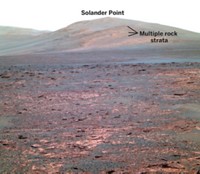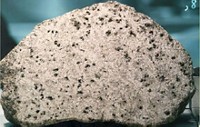Advertisement
Grab your lab coat. Let's get started
Welcome!
Welcome!
Create an account below to get 6 C&EN articles per month, receive newsletters and more - all free.
It seems this is your first time logging in online. Please enter the following information to continue.
As an ACS member you automatically get access to this site. All we need is few more details to create your reading experience.
Not you? Sign in with a different account.
Not you? Sign in with a different account.
ERROR 1
ERROR 1
ERROR 2
ERROR 2
ERROR 2
ERROR 2
ERROR 2
Password and Confirm password must match.
If you have an ACS member number, please enter it here so we can link this account to your membership. (optional)
ERROR 2
ACS values your privacy. By submitting your information, you are gaining access to C&EN and subscribing to our weekly newsletter. We use the information you provide to make your reading experience better, and we will never sell your data to third party members.
Environment
Safeguarding NASA's Moon Rocks
Lab at Johnson Space Center preserves 40-year-old lunar samples for study
by David Pittman
August 16, 2010
| A version of this story appeared in
Volume 88, Issue 33

It’s been four decades since astronauts last visited the moon, yet scientists today are still piecing together the puzzle created by the samples collected. Stored in a veritable Fort Knox for moon rocks, the material helps provide clues to the moon’s formation and makeup.
The National Aeronautics & Space Administration stores nearly 400 lb of lunar dirt, rocks, and glass in a two-story building on the northeast corner of the Johnson Space Center, in Houston, and researchers study the material today. Astronauts gathered the artifacts as scientific payoff from six Apollo missions from 1969 to 1972.
NASA built the lab, which opened in the summer of 1979, for around $2 million after it realized the precious material needed a safe home. “Certainly by the science world, and NASA as well, this was considered an irreplaceable national treasure. These were samples from space and not so easy to get,” says NASA’s Lunar Sample Curator Gary E. Lofgren. “It’s our intention that these samples will be preserved ad infinitum.”
Closely monitored, the samples are packed in heat-sealed Teflon bags and sit in cabinets pumped full of nitrogen. NASA aims to keep the samples in the condition they were in when they were brought to Earth. The space agency hopes to allow scientists to study the pristine samples as if they were on the surface of the moon some 230,000 miles away.
From examining the lab’s rocks, “we’ve realized that the moon formed fairly early in the solar system’s history, probably within the first 30 million years,” says Erik Hauri, a geochemist with the Carnegie Institution for Science (CIS), in Washington, D.C.
With scientific knowledge at stake, NASA goes to extreme lengths to preserve lunar samples, which would slowly degrade if improperly handled. Because the moon has no atmosphere, no free oxygen, and no surface water, materials exist in their most reduced states. For example, on the moon iron can be found in the Fe(II) oxidation state or as pure metallic Fe(0). “On Earth, you just don’t find that,” Lofgren says. Instead, earthbound iron exists more commonly as Fe(III).
To protect them from even the most humid of Houston days, lunar samples are stored in aluminum alloy and stainless steel containers. NASA trucks in liquid nitrogen and uses the gas from its evaporation to pump into the storage vault. Sensors constantly monitor levels of water and oxygen in the cabinets, and an alarm sounds if the concentration of either substance reaches more than 10 ppm. Lofgren says these levels are typically about 5 ppm in the cabinets.
All samples sit behind a door that can be made watertight in a vault that’s roughly 40 feet by 40 feet. The facility is equivalent to a Federal Reserve Bank’s vault, Lofgren says, and is protected from the effects of hurricanes and other natural disasters.
At certain times, lunar materials do leave their stronghold, though. NASA doles out 300 to 400 samples per year for research. To obtain materials from the lab, scientists must submit a proposal describing their work. Requests are reviewed by a NASA-appointed committee of experts in the field. “The only restriction is that it has to be quality science,” Lofgren says. The samples average about 1 g each, so “a 10-g sample would be considered monstrous, and you really have to justify it well that you need that much material,” he says.
NASA doesn’t expect to have the material returned. Researchers sometimes destroy the samples they receive in testing, and as a result, the space agency’s collection of lunar material has dropped from 842 lb in 1972 to about 380 lb today.
Because of their efforts to preserve the samples, NASA and its scientists have gained insight into Earth’s only satellite. “Everybody knew that instruments were going to improve over the years. Of course, that’s exactly what happened,” says Lofgren, who has managed the lunar lab for the past 11 years. “People are making new discoveries all the time.”
Such analytical improvements have provided glimpses of what the moon is like and what secrets make up its history, but those images don’t coalesce into a clear picture. For example, a pair of studies published within the past few months disagree over the presence of water in lunar rocks.
Earlier this summer, a team of scientists from CIS reported that they had found evidence that the moon contains water in the parts-per-million range; that’s more than 100 times as high as what was previously thought (C&EN, June 21, page 27). The researchers used secondary ion mass spectrometry (SIMS) to look for hydroxyl groups in the mineral apatite from lunar samples.

But just this month, a University of New Mexico team concluded that the moon has long been bereft of water (C&EN, Aug. 9, page 31). This group used mass spectrometry to study isotopes of chlorine, a sensitive indicator of hydrogen levels, in the lab’s rocks.
The first hints that the moon might contain water were announced two years ago on the basis of an analysis of lunar volcanic glass beads (C&EN, July 14, 2008, page 34). “Until that point, the various methods used to detect magmatic water had detection limits that weren’t good enough,” says Hauri, a member of the CIS team that conducted the research.
Those breakthroughs came with a new generation of SIMS called nanoSIMS. In this method, an instrument focuses an ion beam to a spot less than 1 µm in diameter in order to sputter material from samples. Hauri’s group first obtained a nanoSIMS instrument in 2006, shortly after it became commercially available, and used it to analyze water dissolved in volcanic glass. NanoSIMS allows researchers to ignore ions from the very edge of the sputtered area and count only those that come from the center. “That by itself allows us to drop the detection limit for water down to about 1 ppm,” Hauri says.
Researchers have been looking at lunar samples for more than traces of water. For example, a team at California Institute of Technology that also used nanoSIMS to study material from the NASA lab recently reported that a lunar volcanic rock contained as much hydrogen, chlorine, and sulfur as a common igneous rock on Earth (Nature, DOI: 10.1038/nature09274). And the moon contains graphite, according to researchers who found this form of carbon in rocks returned on the Apollo 17 mission (Science 2010, 329, 51). They studied the lunar samples with Raman spectroscopy. According to Hauri, advances in laser ablation inductively coupled plasma mass spectrometry have also allowed researchers to isolate a multitude of elements in a single sample.
“You look at the same lunar rocks again, and everybody says, ‘Didn’t you know that before? How come you’re just now discovering things 40 years later?’ ” says Lawrence A. Taylor, director of the Planetary Geosciences Institute at the University of Tennessee, Knoxville. “We didn’t have the smarts to point us in certain directions back then, and we didn’t have the instrumentation.
“The sophistication of cutting-edge instruments, such as those used in nanoSIMS, has gotten to such a stage that we can not only examine very small areas” of the samples, Taylor continues, “but we can also do miraculous types of trace-element chemistry on them.”
Even though NASA doesn’t plan to return to the moon in the immediate future, researchers trust that the lab in Houston will keep safe the samples astronauts have already brought back.




Join the conversation
Contact the reporter
Submit a Letter to the Editor for publication
Engage with us on Twitter